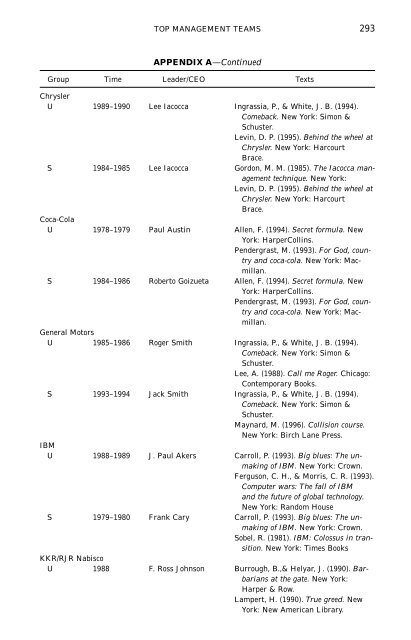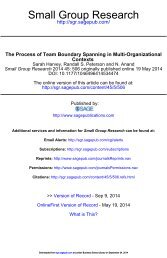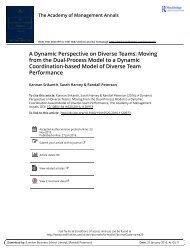Group Dynamics in Top Management Teams: Groupthink, Vigilance, and Alternative Models of Organizational Failure and Success
This study explored the heuristic value of Janis’ (1982) groupthink and vigilant decision making models as explanations of failure and success in top management team decision making using the Organizational Group Dynamics Q-sort (GDQ). Top management teams of seven Fortune 500 companies were examined at two historical junctures—one when the team was successful (defined as satisfying strategic constituencies) and one when the team was unsuccessful. Results strongly supported the notion that a group’s decision making process is systematically related to the outcomes experienced by the team. Ideal-type Q-sorts organized around Janis’ analysis of groupthink and vigilance were substantially correlated with Q-sorts of failing and successful groups, respectively. The fit was, however, far from perfect. Ideal type Q-sorts derived from other frameworks correlated better with the failure–success classification than did the Janis-derived ideal types. Successful groups showed some indicators of groupthink (e.g., risk-taking, cohesion, and strong, opinionated leaders), whereas unsuccessful groups showed signs of vigilance (e.g., internal debate to the point of factionalism). The results illustrate the usefulness of the GDQ for developing and empirically testing theory in organizational behavior from historical cases.
This study explored the heuristic value of Janis’ (1982) groupthink
and vigilant decision making models as explanations of
failure and success in top management team decision making
using the Organizational Group Dynamics Q-sort (GDQ). Top
management teams of seven Fortune 500 companies were examined
at two historical junctures—one when the team was successful
(defined as satisfying strategic constituencies) and one when the team was unsuccessful. Results strongly supported the notion
that a group’s decision making process is systematically related
to the outcomes experienced by the team. Ideal-type Q-sorts organized
around Janis’ analysis of groupthink and vigilance were
substantially correlated with Q-sorts of failing and successful
groups, respectively. The fit was, however, far from perfect. Ideal type
Q-sorts derived from other frameworks correlated better
with the failure–success classification than did the Janis-derived
ideal types. Successful groups showed some indicators of groupthink
(e.g., risk-taking, cohesion, and strong, opinionated leaders),
whereas unsuccessful groups showed signs of vigilance (e.g.,
internal debate to the point of factionalism). The results illustrate
the usefulness of the GDQ for developing and empirically testing
theory in organizational behavior from historical cases.
- No tags were found...
Create successful ePaper yourself
Turn your PDF publications into a flip-book with our unique Google optimized e-Paper software.
TOP MANAGEMENT TEAMS 293<br />
APPENDIX A—Cont<strong>in</strong>ued<br />
<strong>Group</strong> Time Leader/CEO Texts<br />
Chrysler<br />
U 1989–1990 Lee Iacocca Ingrassia, P., & White, J. B. (1994).<br />
Comeback. New York: Simon &<br />
Schuster.<br />
Lev<strong>in</strong>, D. P. (1995). Beh<strong>in</strong>d the wheel at<br />
Chrysler. New York: Harcourt<br />
Brace.<br />
S 1984–1985 Lee Iacocca Gordon, M. M. (1985). The Iacocca management<br />
technique. New York:<br />
Lev<strong>in</strong>, D. P. (1995). Beh<strong>in</strong>d the wheel at<br />
Chrysler. New York: Harcourt<br />
Brace.<br />
Coca-Cola<br />
U 1978–1979 Paul Aust<strong>in</strong> Allen, F. (1994). Secret formula. New<br />
York: HarperColl<strong>in</strong>s.<br />
Pendergrast, M. (1993). For God, country<br />
<strong>and</strong> coca-cola. New York: Macmillan.<br />
S 1984–1986 Roberto Goizueta Allen, F. (1994). Secret formula. New<br />
York: HarperColl<strong>in</strong>s.<br />
Pendergrast, M. (1993). For God, country<br />
<strong>and</strong> coca-cola. New York: Macmillan.<br />
General Motors<br />
U 1985–1986 Roger Smith Ingrassia, P., & White, J. B. (1994).<br />
Comeback. New York: Simon &<br />
Schuster.<br />
Lee, A. (1988). Call me Roger. Chicago:<br />
Contemporary Books.<br />
S 1993–1994 Jack Smith Ingrassia, P., & White, J. B. (1994).<br />
Comeback. New York: Simon &<br />
Schuster.<br />
Maynard, M. (1996). Collision course.<br />
New York: Birch Lane Press.<br />
IBM<br />
U 1988–1989 J. Paul Akers Carroll, P. (1993). Big blues: The unmak<strong>in</strong>g<br />
<strong>of</strong> IBM. New York: Crown.<br />
Ferguson, C. H., & Morris, C. R. (1993).<br />
Computer wars: The fall <strong>of</strong> IBM<br />
<strong>and</strong> the future <strong>of</strong> global technology.<br />
New York: R<strong>and</strong>om House<br />
S 1979–1980 Frank Cary Carroll, P. (1993). Big blues: The unmak<strong>in</strong>g<br />
<strong>of</strong> IBM. New York: Crown.<br />
Sobel, R. (1981). IBM: Colossus <strong>in</strong> transition.<br />
New York: Times Books<br />
KKR/RJR Nabisco<br />
U 1988 F. Ross Johnson Burrough, B.,& Helyar, J. (1990). Barbarians<br />
at the gate. New York:<br />
Harper & Row.<br />
Lampert, H. (1990). True greed. New<br />
York: New American Library.

















